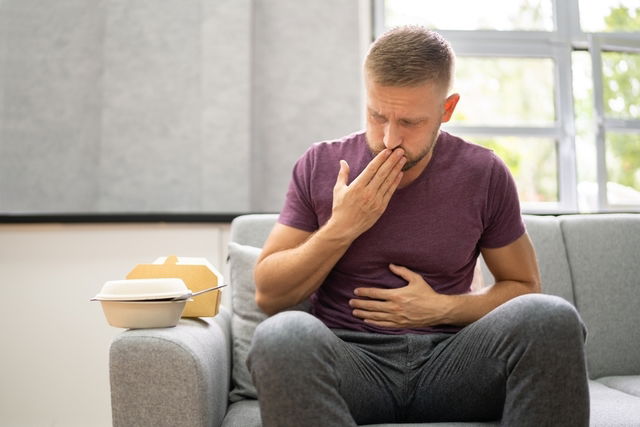Erosive esophagitis is a condition associated with inflammation and tissue damage along the lining of esophagus. This damage is a result of chronic gastric reflux, and leads to symptoms like pain when eating or drinking, vomiting with blood and blood in the stool.
The type of erosive esophagitis can be sorted according to the Los Angeles Classification System, where grade A esophagitis is associated with lesions smaller than 5 mm and grade D esophagitis is the most serious, with lesions that take up more than 75% of the esophagus.
Treatment is usually monitored by a gastroenterologist, who may prescribe medication that decreases or prevents stomach acid production. More serious cases may require surgical repair of the esophageal lining. Diet changes are typically also necessary to ensure symptom relief and to prevent worsening.

Main symptoms
Symptoms of erosive esophagitis depend on the severity of tissue damage in the esophagus. Patients typically report:
- Vomiting, with or without blood
- Pain when eating or drinking
- Blood in the stools
- Sore throat
- Hoarseness
- Chest pain
- Chronic coughing
Erosive esophagitis that is left untreated can lead to anemia (due to decreased iron absorption), as well a higher risk for esophageal tumors. Therefore, it is important to see a doctor if you notice and signs or symptoms, so that treatment can be initiated promptly.
Confirming a diagnosis
Diagnosis of erosive esophagitis is confirmed by the doctor through assessment of the presenting symptoms. The doctor will likely ask questions about factors that worsen or improve symptoms.
The doctor may also order an endoscopy, which allows for visualization of inflammation and damage in the esophagus and stomach. The severity of esophagitis is rated using the Los Angeles Classification, ranging from LA Grade A to D.
Los Angeles Classification
LA Classification is a scoring system that grades the severity of esophageal tissue damage based on assessment through endoscopy. Attributing a grade helps to guide appropriate treatment and management of esophagitis.
Erosive esophagitis classified as LA Grade C or LA Grade D is often recurrent and poses a greater risk for esophageal cancer. Surgical interventions may be started first, followed by medication therapy.
Common causes
In most cases, erosive esophagitis occurs as a result of untreated esophagitis. Chronic inflammation can lead to the formation of wounds and tissue damage along the esophageal lining.
Gastroesophageal reflux disease (or GERD) can also lead to erosive esophagitis. This condition is characterized by the backflow of stomach acid into the esophagus, which irritates the tissue and causes damage.
Erosive esophagitis occurs more frequently in smokers and in those who frequently consume processed or fatty food.
Treatment options
Treatment for erosive esophagitis depends on the underlying cause. The doctor may recommend regular follow-ups with a registered dietitian, who may advise a GERD diet, smoking cessation, and weight loss if applicable.
The doctor may prescribe medications like:
- Protein pump inhibitors (PPI), like omeprazole or lansoprazole. These inhibit stomach acid production to prevent it from eaching the esophagus.
- Histamine H2-receptor antagonists, like famotidine, cimetidine and niatidine. These are used by PPIs are not effective, and also help to reduce stomach acid production.
- Prokinetics, like domeridone and metoclopromide. These help to speed-up stomach emptying.
Patients who take anti-cholinergics (like hyoscyamine or scopolamine) or calcium channel blockers (like amlodipine or verapamil) may receive specific instructions for taking esophagitis-related medication.
Surgical repair is only recommended for tissue damage that does not improve, if symptoms persist, and if other treatment options have been exhausted. Surgery consists of constructing a small valve that connects the stomach to the esophagus, to prevent stomach acid from coming in contact with damaged areas.
Also recommended: Home Remedies for Gastritis: 10 Natural & Proven Recipes tuasaude.com/en/home-remedies-for-gastritisTreatment for pregnant women
Pregnant women with erosive esophagitis are advised to consult a registered dietitian about necessary diet changes. The medications most safe for use during pregnancy are histamine H2-receptor antagonists, like famotidine, ranitidine, and cimetidine.
See other ways to treat heartburn during pregnancy safely at home.
Other considerations
In addition to following a prescribed treatment plan, some other consideration when managing symptoms of erosive esophagitis include:
- Elevating the head of the bed 15 to 30 cm when lying down
- Avoiding trigger foods, like citric fruit, caffeine, alcohol,fizzy drinks, mint, eucalyptus, peppermint, tomato and chocolate.
- Ensuring no food intake 2 hours before lying down or going to sleep.
These are the same recommendation given to those who suffer from acid reflux. Check-out other acid reflux home remedies that you can try to reduce symptoms of erosive esophagitis.
